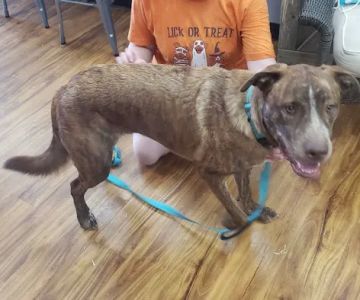Managing Your Pet’s Allergies with Diet: A Complete Guide
- Understanding Pet Allergies
- How Diet Can Help Manage Pet Allergies
- Best Foods for Pets with Allergies
- Common Food Allergens for Pets
- Tips for Switching Your Pet's Diet Safely
- Real-Life Experiences with Pet Diet Changes
1. Understanding Pet Allergies
Pet allergies are a common issue that many pet owners face, and they can cause discomfort and even serious health issues for our furry friends. Allergies in pets can manifest in various ways, including itchy skin, ear infections, digestive issues, and more. The causes of these allergies can vary, but food allergies are among the most prevalent triggers.
Just like humans, pets can develop sensitivities to certain ingredients in their food. While some pets may be allergic to environmental allergens like pollen or dust mites, food allergies are typically linked to proteins, grains, or additives found in commercial pet food.
As a responsible pet owner, understanding what causes your pet's allergies and how to manage them effectively is essential. One of the most effective ways to address food allergies in pets is by adjusting their diet. By choosing the right foods and eliminating allergens from their meals, you can help improve your pet’s overall health and comfort.
2. How Diet Can Help Manage Pet Allergies
Managing your pet’s allergies with diet involves identifying and eliminating the specific ingredients that are causing the allergic reactions. This process typically begins with consulting your vet, who may recommend an elimination diet to pinpoint the allergen.
A proper diet can work in multiple ways to alleviate allergy symptoms in pets. First, it can help to reduce inflammation in the body, which is often a result of allergic reactions. Additionally, some ingredients in pet food have natural antihistamine properties that can help control allergic responses.
Furthermore, a specialized diet may help to strengthen your pet’s immune system, allowing them to better handle environmental allergens or food triggers. By providing your pet with high-quality, hypoallergenic food, you can give them the nutrition they need without the ingredients that could cause adverse reactions.
3. Best Foods for Pets with Allergies
When selecting the best food for a pet with allergies, it’s essential to focus on hypoallergenic options that contain limited ingredients. These foods are designed to reduce the likelihood of an allergic reaction while providing the necessary nutrients. Here are some of the best foods for pets with allergies:
- Limited Ingredient Diets (LID): These diets are made with fewer ingredients, which makes it easier to identify any allergens your pet may be sensitive to. LID foods typically feature a single source of animal protein and a simple carbohydrate source.
- Grain-Free Pet Foods: Many pets are allergic to grains like wheat, corn, or soy. Grain-free pet foods eliminate these potential allergens and often use potatoes or peas as carbohydrate sources.
- Hydrolyzed Protein Diets: These diets use proteins that have been broken down into smaller molecules, making them less likely to cause an allergic reaction. They are especially useful for pets with severe protein sensitivities.
- Novel Protein Foods: These foods use proteins that your pet has never been exposed to before, such as duck, venison, or kangaroo. Novel proteins are often recommended for pets that have developed allergies to more common protein sources like chicken or beef.
Choosing the right food for your pet’s allergies can greatly reduce their symptoms and improve their quality of life. However, it’s essential to remember that dietary changes should always be done gradually, and with the guidance of your veterinarian.
4. Common Food Allergens for Pets
While each pet may have individual sensitivities, there are several common food allergens that affect many pets. Knowing which ingredients to avoid is key to managing your pet’s allergies. Some of the most common food allergens include:
- Beef: Beef is one of the most common protein allergens for pets. If your pet is allergic to beef, it can lead to skin problems, gastrointestinal issues, and ear infections.
- Chicken: Chicken is another common protein source that may trigger allergies. Symptoms can include itchy skin, vomiting, and diarrhea.
- Dairy: Many pets are lactose intolerant, meaning they cannot properly digest dairy products. This can lead to digestive upset, including bloating, diarrhea, and vomiting.
- Grains: Wheat, corn, and soy are common allergens in many commercial pet foods. Pets with grain allergies may experience itchy skin, ear infections, or gastrointestinal issues.
- Fish: While less common, some pets are allergic to fish, leading to symptoms such as skin rashes, vomiting, and diarrhea.
By avoiding these common allergens and opting for hypoallergenic pet foods, you can help your pet feel more comfortable and reduce the risk of allergic reactions.
5. Tips for Switching Your Pet's Diet Safely
Switching your pet’s diet can be a delicate process, especially if they have allergies. It’s important to transition gradually to avoid upsetting their digestive system. Here are some tips for safely switching your pet’s food:
- Gradual Transition: Start by mixing the new food with the old food, gradually increasing the amount of new food while decreasing the old food. This process should take about 7-10 days to avoid digestive upset.
- Monitor for Reactions: As you transition your pet to their new diet, keep an eye out for any allergic reactions, such as vomiting, diarrhea, or skin issues. If you notice any symptoms, consult your veterinarian immediately.
- Stick to the Plan: Once you’ve successfully switched to a hypoallergenic diet, it’s important to maintain consistency. Avoid giving your pet treats or human food that could contain potential allergens.
By following these tips, you can ensure a smooth transition to a new diet that helps manage your pet’s allergies while supporting their overall health.
6. Real-Life Experiences with Pet Diet Changes
Many pet owners have shared their success stories when it comes to managing allergies through diet. One such case comes from Jessica, who struggled with her dog Max’s constant skin issues and ear infections. After switching him to a limited ingredient diet, Max’s symptoms began to improve, and his skin cleared up within a few weeks.
Another pet owner, Lisa, shared her experience with her cat, Bella, who was frequently vomiting and had digestive issues. After consulting with her vet and switching Bella to a hydrolyzed protein diet, the symptoms subsided, and Bella’s overall health improved.
These real-life examples highlight the positive impact that a thoughtful diet change can have on your pet’s health, making it a key strategy in managing food allergies and enhancing their quality of life.











